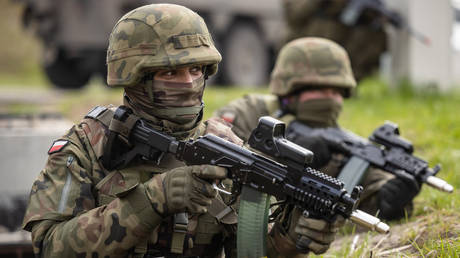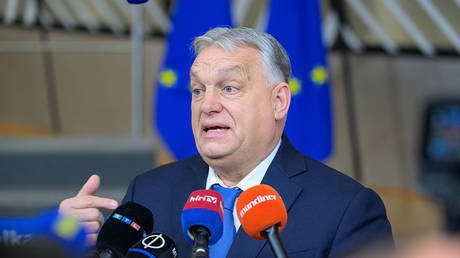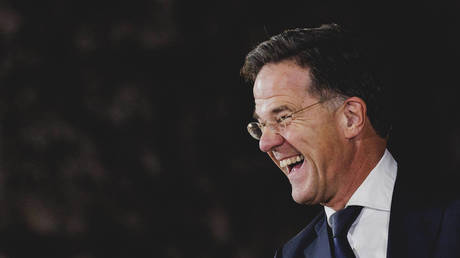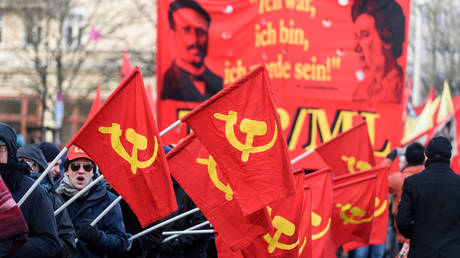
The imagined threat of Moscow being about to march on Western Europe is a very lucrative idea for warmongers and arms dealers
NATO’s peddling of a “Russian threat” is reaching telethon levels of relentlessness – worse than a house alarm salesman in TV advertisements talking up the scary burglar.
Poland’s top general, Wieslaw Kukula, said recently that “Russia is preparing for a conflict with NATO, aware that the alliance is a defensive structure.” For French President Emmanuel Macron, playing “defense” apparently involves sending a bunch of players deep into the other guy’s end-zone to score. Macron has been overtly talking about sending troops to fight Russia while giving the impression that he’s personally training to take on Russian President Vladimir Putin by posing for black and white glamour shots complete with boxing gloves and flexed biceps that may or may not have been the result of having Monsieur Photoshoppe as his personal trainer. Estonia’s foreign intelligence chief conveniently describes Russia’s strategy as “long-term confrontation.” The European Union’s internal markets commissioner, Thierry Breton, has said “we need to change the paradigm and move into war economy mode.” Andre Berghegger, head of the association of German city councils, is talking about reviving the bomb shelter business. “During the Cold War, Germany had more than 2,000 public shelters. Only 600 of these still exist, providing protection for around 500,000 people. There is an urgent need to put decommissioned bunkers back into operation. And we need to build new, modern shelters. In urban centers, underground car parks and subway shafts can certainly be used,” the official said.
Sure, why not? If the military industrial complex is going to try convincing taxpayers to let the government take all their money to make weapons, then why shouldn’t the bomb shelter business also get in on the action? Not a bad time to resurrect the bunker industry, actually. With energy costs and interest rates becoming a problem for Europeans, maybe everyone can just save some money and move into government-funded bunkers and hang out while waiting for Putin to show up.
What do you do when you’ve devastated your own normal economy “for Ukraine,” and have nothing to show for it? Announce that you now self-identify as a wartime one and attempt to scare up some cash from your taxpayers for the transition.
So now what we’re seeing is European countries ramping up defense spending while at the same time saying they don’t really have any cash to spare for things like social programs, or to sufficiently compensate their own farmers being screwed over by the EU’s free trade policy favoring Ukraine’s farming industry over Europe’s own. Don’t like it? Well then, do you really want Putin rolling right up to a Left Bank Parisian café in a battle tank? They’re talking like that’s where he’s literally going to be – ordering foie gras from the mid-day menu – if the European taxpayers don’t start wrapping their heads around the idea that making weapons is now suddenly Europe’s big priority. So how’s that sell-job actually working on the taxpayers? Not that great. Which might explain why they’re ratcheting up the rhetoric to ridiculous levels.
Poland in particular has been a big beneficiary of all the fear porn, with US Congress having approved $288 million worth of foreign military financing in 2022 for Poland under the guise of countering Russia. Warsaw has also scored $34 million in security assistance to improve intelligence capabilities and military mobility over the past six years, with $1.2 billion in sales of US defense articles to Poland between 2019 and 2021 alone, according to the US State Department. Last year, Warsaw scored a $2 billion “loan” from Washington for military equipment to purchase American weapons, plus a gift of $60 million to offset its financing.
All the Russian threat rhetoric has been conveniently non-specific. But why get precise when it would run the risk of being debunked? There are two exceptions, however: the Suwalki Gap and Transnistria.
NATO has long been obsessed with the Suwalki Gap – the hundred-kilometer strip along the Polish-Lithuanian border, sandwiched between the Russian exclave of Kaliningrad in the west and Belarus in the east. Last summer, the Polish defense minister conveniently flipped out over the fact that Russian private military Wagner Group fighters who were formerly active in the Ukraine conflict had effectively been exiled to Belarus in the wake of their public meltdown and long march towards Moscow over differences with Russian military leadership. Just the thought of Wagner fighters sitting around, maybe cracking open a few beers, somewhere in the vicinity of Minsk, was apparently enough for NATO to start having visions of the Wagner guys making an armed road trip to Poland from the east while Russian troops in Kaliningrad come in from the west. Who knows why NATO thinks they’d want to do that. But pretty much any excuse or pretext will do when it comes to Poland being able to load up on weapons and play the role of NATO attack dog that always seems like it’s on the verge of chewing through its harness.
Belarusian President Alexander Lukashenko suggested to Putin at the time that Poland planned to attack Belarus, with a thousand Polish soldiers recently cozying up to the border under the pretext that Wagner troops were now hanging out with Belarusian troops on the other side of it. But Lukashenko also offered another explanation for Poland’s military buildup, explaining that south of the Suwalki Gap, just below Belarus, is western Ukraine, and that Poland wanted to get its hands on a piece of it. Lukashenko’s suggestion that Poland was itching to get its hands dirty in Ukraine echoes what Putin told the Russian Security Council, that Poland wanted to get more deeply involved in Ukraine to nab for itself a slice of what Warsaw considers to be its historical territory.
Much NATO handwringing has also taken place over the so-called Russian threat to Transnistria — a demilitarized zone that broke away from Moldova at the end of the Cold War and is now a de facto independent republic. If you haven’t heard much about Transnistria until recently, if at all, it’s because it’s stable, with Russian peacekeeping troops holding down the fort. Back in June 2023, at the European Union Political Community kiddie table summit for countries wanting to join the EU, Ukrainian President Vladimir Zelensky said that he wanted the EU to go bang on Transnistria’s door, as though he didn’t have enough of his own problems. Zelensky said that Ukraine was willing to help fight the Russian peacekeeping troops in Transnistria, but would just need a request from Moldova.
Nice “defensive alliance” you’ve got there, guys. You really sure that Russia’s the problem here? Or maybe your worldview is as detached from reality as the idea of Macron’s newly bulging biceps being, as his wife Brigitte says, the result of two 45-minute weekly workouts?




